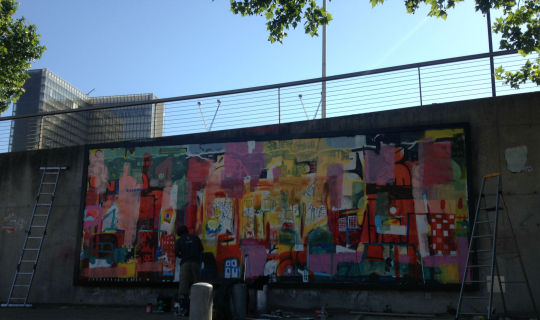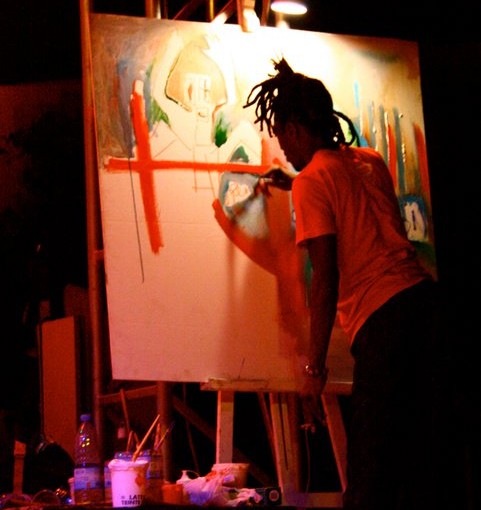Black(s) to the future: How did you get the idea for the mural? What did you want to tell through this piece of art?
Amadou Tounkara : This year, the festival was to honor Senegal, It’s in this context that I was prompted to create this mural, as a Senegalese artist currently residing in France. I always work around the same themes: the representation of doors and windows, symbolizing openness, the transition from one society to another… Given the time and size of the work, I appealed to My friend Ndoye Douts (note: visual artist stems from the Dakar School, artistic renewal movement born in Senegal at the dawn of the country’s independence). What you see at the moment is a draft of our work: we are only at the beginning!

B(s)ttf : You’ve lived in Japan for many years and exhibited your works several times in this country. What has been the reception of your art?
A.T. : I lived 10 years in Japan. When I got there, I saw how glaring the differences were. Their society seemed diametrically opposed to everything I had known before. The material used was not the same, for example. The Japanese were very attached to their own culture: manga, crafts, to name it; there was at the time little space for contemporary art, what is more, African.
During my first exhibitions / artistic events, the public expected a stereotyped image of “African art” See masks and statues, and dwell on the symbolism of the representative pieces of African art as we hear it. By surprise, my works have been well received. The audience was interested in the colors used, while everything was rather monochrome, then the messages conveyed, which removed them from their original vision of “African art”. The subjects I mentioned concerned as well prisoners in the street, as immigrants unable to return to their country of origin. The contrast between the colorful aspect of my work and political dimension has really appealed to Japanese.
B(s)ttf : You also paint on fabric. As part of this work carried out for the festival, how do you proceed?
A.T.: We brought a painting workshop that we have applied to the wall and it is from this wall we created the work, itself. Here, the fabric is applied to an integrated wooden support wall adjacent to the auditorium.
________________________________________________________________________
Variations on the same theme: Pressionism
| See, from March 12 to September 12, 2015, the exhibition of the Art Gallery of Paris: “The pressionism 1970-1990 masterpieces on canvas graffiti Basquiat in Bando” for highlighting a unfairly associated with the movement tag, misidentified by the official art history, representing one of the most popular trends of contemporary art. |
________________________________________________________________________
B(s)ttf : What are the relationships you maintain with Senegal today?
A.T. : Before going to Japan, I had already stated in Senegal; the need for renewal was I stopped for a time to have any connection with my country of origin, except for personal reasons. It was at the occasion of the Biennale of Contemporary African Art, in 2010, we appealed to me from Japan to come expose Senegal. Since then, while being resident in France, I made some stays of several months in Senegal and was again in contact with the Senegalese cultural scene. I try to speak more and more projects with the artists there, and I see the emergence of a new stage and denotes a real synergy between its various players. Between designers and musicians, to name Faada Freddy for example, the Senegalese cultural scene is currently in full swing!
B(s)ttf : What would be your own definition of afrofuturism?
A.T. : I think we should talk about the cultural development of Africa and discuss its potential has never been fully exploited so far as Africa is central to many issues. The energy, the dynamism that emanates from the African cultural scene today will take us to the explosion of a major cultural trend we can observe in the coming years. We have nothing to envy of our peers!
Thank you very much to Amadou Tounkara and Frédérique Miguel for their collaboration.
